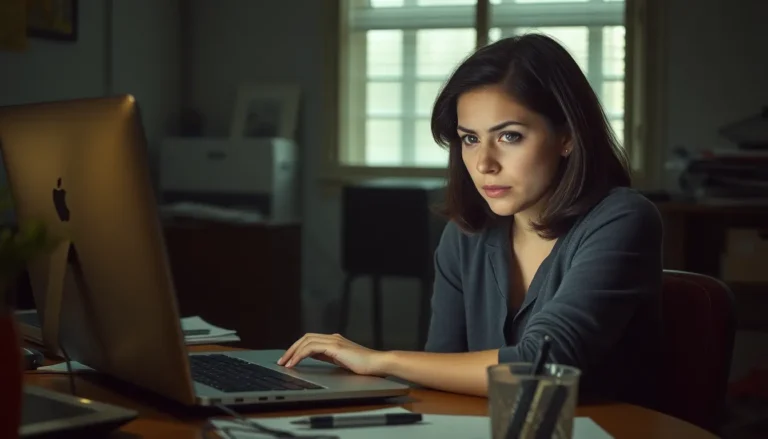Table of Contents
ToggleEver found yourself staring at an image in Google Docs, wishing it could talk? Well, it can’t, but you can give it a voice! Adding a text box to an image is like giving your pictures a stylish pair of glasses—suddenly they look smarter and more interesting. Whether you’re crafting a presentation, designing a report, or just trying to impress your cat with your tech skills, adding text boxes can elevate your visuals from “meh” to “wow.”
Understanding Google Docs Features
Google Docs offers various tools designed for seamless content creation and editing. Text boxes serve as a versatile feature, enhancing images and providing context. Users can personalize presentations and documents by placing text boxes over images, adding descriptions or titles.
Image formatting options include resizing, rotating, and layering text boxes. These functions enable users to achieve the desired visual impact. Customization features, like adjusting the background color and border of a text box, add to the aesthetics, making documents more visually appealing.
Collaboration remains a key advantage within Google Docs. Multiple users can edit documents simultaneously, allowing for real-time adjustments. When a text box is added, collaborators can easily make changes, ensuring everyone contributes effectively. An intuitive interface simplifies the process of adding and editing text boxes, making it accessible for all skill levels.
Accessibility features, such as keyboard shortcuts, facilitate quicker navigation through the document. Incorporating images with text helps convey information clearly. Adding alt text to images with text boxes also enhances accessibility for users with visual impairments.
Overall, Google Docs empowers users by providing robust features. The option to add text boxes to images stands out as a way to enrich content. Enhanced visuals improve the overall design and make presentations more engaging, catering to various types of users and projects.
Preparing Your Image
Preparing an image for text box insertion in Google Docs involves two key steps: choosing the right image and uploading it to the document. This preparation ensures optimal visual enhancement.
Choosing the Right Image
Selecting an appropriate image greatly impacts the overall effectiveness of your text box. Images should align with the document’s theme, whether it’s a report, presentation, or personal project. Clarity is crucial; high-resolution images maintain quality when resized. Consider images that have ample space for text, avoiding overly busy visuals. Using images that complement the content facilitates better engagement and understanding.
Uploading the Image to Google Docs
Uploading images to Google Docs is straightforward. First, open your document and navigate to the “Insert” menu. From there, select “Image” and choose a preferred option, such as “Upload from computer” or “Search the web.” Alternately, you can drag and drop the image directly into the document. Once uploaded, positioning the image correctly on the page enhances its visibility and allows for seamless integration with text boxes. Adjust the image size as necessary using the corner handles for a perfect fit.
Adding a Text Box
Adding a text box to an image in Google Docs enhances the visual appeal and provides context to the visuals. This process requires using the Drawing tool effectively.
Accessing the Drawing Tool
To start, navigate to the menu bar and click on “Insert.” Selecting “Drawing” opens a dropdown where “New” can be chosen. This action opens a drawing canvas, allowing users to insert shapes and text. Familiarity with the interface makes it easier to manipulate the drawing. When the canvas is ready, it becomes clear that adding text boxes is straightforward. The tool facilitates creativity, allowing for various designs within the text box.
Creating the Text Box
After accessing the Drawing tool, create a text box by selecting the “Text box” icon in the toolbar. Click and drag on the canvas to define the box size. Input relevant text that complements the image. Adjust the font style, size, and color for improved visibility. Text alignment can create a clean, polished look. As users finalize the text box, clicking “Save and Close” saves the drawing in the document. The image now becomes more informative, enhancing the overall design.
Positioning the Text Box
Positioning the text box correctly enhances the overall appearance of the image and document. Proper placement ensures readers can easily engage with the content.
Adjusting Size and Placement
Adjusting the size of the text box is straightforward. Users can click on the text box and drag the corners to resize it. Placing the text box near the focal point of the image draws attention. Users often position it centrally or aligned to the left or right, based on the image layout. Ensuring sufficient space around the text box prevents clutter, allowing for clear readability. Use the alignment tools in the Drawing tool sidebar for precise positioning.
Formatting the Text Box
Formatting the text box improves its visual appeal and readability. Users can change font styles, sizes, and colors to match the document’s theme. Adding a background color to the text box can create contrast against the image. Borders can also be modified to enhance visibility. Experimenting with different font weights helps emphasize key points. Using clear and concise text keeps the message effective and engaging. These formatting options can elevate the visual impact, making the text box a standout feature in the document.
Finalizing Your Document
Finalizing a document involves ensuring all elements, including text boxes and images, meet desired standards. Users can enhance the overall quality before sharing by reviewing every component for clarity and engagement.
Saving and Sharing Your Work
Saving the document is essential to secure changes made during the editing process. Click on “File” and then “Save” to keep updates safe. Sharing options allow collaboration with others. Users select “Share” in the upper-right corner to invite others via email or link. Permissions can be adjusted to control editing rights. Utilizing “Comment” mode encourages feedback without altering the original design. Google Docs automatically saves progress, but confirming the document’s status provides added assurance. Consider the audience when deciding whether to download or share the link directly. Each option facilitates collaboration and ensures the final product reflects the user’s intent.
Adding text boxes to images in Google Docs transforms simple visuals into compelling pieces of content. This feature not only enhances the aesthetic appeal but also provides essential context and personalization. By following the outlined steps and utilizing Google Docs’ formatting tools, users can create engaging documents that capture their audience’s attention.
Whether for professional presentations or personal projects, the ability to incorporate text boxes allows for clearer communication and a more polished design. With its collaborative capabilities and user-friendly interface, Google Docs stands out as an effective platform for creating visually appealing documents. Embracing these tools can lead to higher engagement and a more impactful presentation of ideas.







